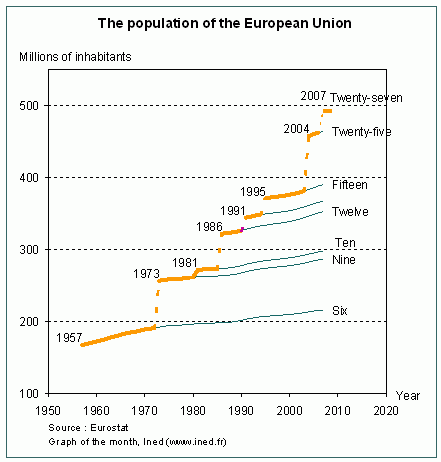The population of the European Union (1957 - 2007)

Reading the graph
This graph presents the population of the European Union, from its initial formation, through successive enlargements, up to 2007.
The thick curve shows the total population of Europe on 1 January of each year, with dotted lines indicating enlargement years. The thin lines show the population growth in the successive groups of member countries.
In 1957, when the European Economic Community (EEC) was established by the Treaty of Rome, the six founding countries totalled 167 million inhabitants (in descending order of population size: Germany, France, Italy, Netherlands, Belgium, Luxembourg). Fifty years later, these six countries now have 215 million inhabitants, as shown by the fine line labelled "Six".
The European Union, which replaced the EEC under the Maastricht Treaty of 1992, comprises 27 countries with 493 million inhabitants in 2007.
Population increase in Europe is due mainly to external growth
In early 1973, three new countries - United Kingdom, Denmark and Ireland (population 64 million) - joined the six founding members of the European Community, raising the population from 192 to 256 million. The enlargement process then continued in successive stages. Greece joined in 1981 (population 10 million), Spain and Portugal in 1986 (49 million), and in 1990 the reunification of Germany brought a further 16 million citizens into Europe. The next enlargement was in 1995, with the accession of Sweden, Austria and Finland (22 million), followed in 2004 by ten new members: Poland, Czech Republic, Hungary, Slovakia, Lithuania, Latvia, Slovenia, Estonia, Cyprus and Malta (74 million). The most recent entrants are Bulgaria and Romania, which joined the EU in 2007 (29 million).
Altogether, these successive enlargements have increased the population of Europe by 264 million, though the six founding countries grew by only 49 million over the same period. It is thanks mainly to "external" growth that the population of the European Union has tripled, rising from 167 to 493 million. Some 15% of this growth (326 million inhabitants) is due to internal growth of the six founding countries, 81% is due to external growth through enlargement and 4% to population growth in the countries that have successively joined the EU.
Sources
The enlarged European Union: fifteen + ten = 455, Alain Monnier Population and Societies n° 398, 2004
